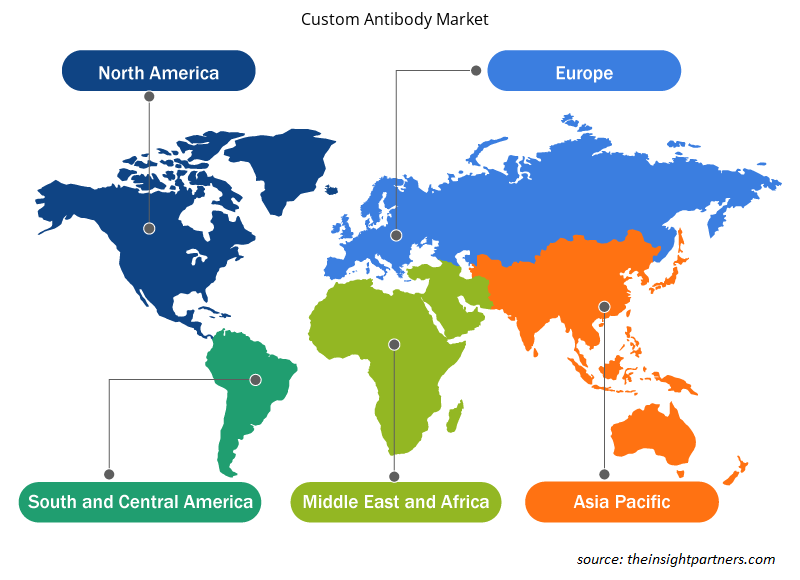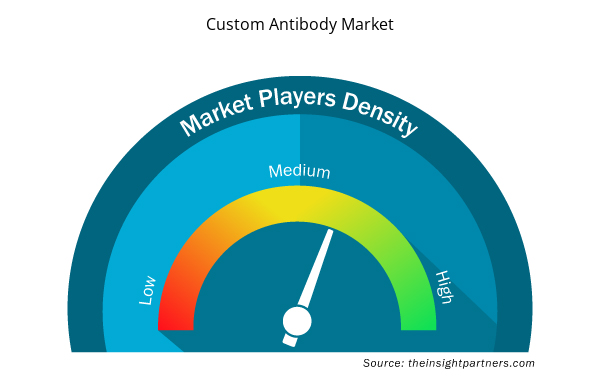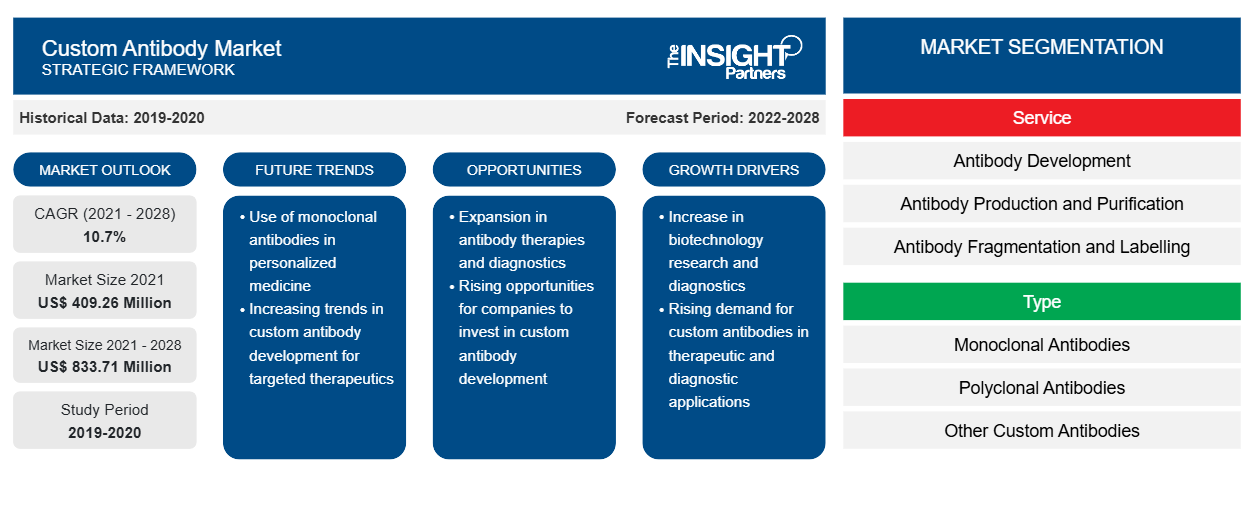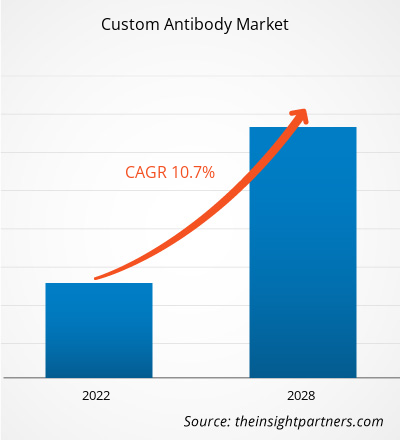定制抗体市场价值将从 2021 年的 4.0926 亿美元增至 2028 年的 8.3371 亿美元;预计从 2021 年到 2028 年的复合年增长率为 10.7%。
定制抗体可以在小鼠、大鼠或仓鼠中生成,以满足任何宿主的要求。公司根据研究人员的要求提供各种抗体。市场上有各种定制抗体,包括多克隆抗体和单克隆抗体、重组单克隆抗体、杂交瘤抗体、多克隆重组抗体等。公司为抗体生产的所有类型和步骤提供完整的支持服务,从肽设计、合成和载体蛋白结合到动物免疫、血清收集或杂交瘤融合、滴度分析和最终抗体纯化。
定制抗体市场的增长归因于以下因素:研究需求旺盛、政府支持力度加大、疾病状况不断变化、公私伙伴关系不断加强以及融资活动不断增加,这些因素正在广泛提高生物技术的性能。然而,单克隆抗体和多克隆抗体的生产因用于生产它们的动物而异。成本还取决于不同参与者提供的不同应用所需的定制抗体包,这阻碍了市场的增长。
定制此报告以满足您的需求
您可以免费定制任何报告,包括本报告的部分内容、国家级分析、Excel 数据包,以及为初创企业和大学提供优惠和折扣
- 获取此报告的关键市场趋势。这个免费样品将包括数据分析,从市场趋势到估计和预测。
市场洞察
定制抗体供应商提供的生产和开发服务
各公司都在积极提供定制抗体的研发服务。以下列出了这些公司推出的一些此类服务。
- 2021 年 6 月,GenScript 宣布推出定制兔单克隆抗体 (mAB) 服务 MonoRab。这是公司综合优质抗体服务组合中新增的服务。MonoRab 是该公司的专有技术,结合了杂交瘤技术和早期单克隆抗体测序。这两种技术都可以提供定制兔单克隆抗体,这些抗体更具特异性,具有更高的亲和力以及广泛应用所需的多样化能力。
- 2021 年 3 月,Giotto Biotech 推出了专门的多克隆和单克隆抗体生产服务。该公司促进了 500 多种可用于诊断和治疗应用的单克隆抗体类型的生产。它提供了大量物种作为多克隆抗体来源的选择。
- 2020 年 11 月,AMSBIO 宣布提供兔和鼠重组单克隆抗体的开发服务。重组单克隆抗体的开发基于 DimAb 开发平台,该平台不同于传统的杂交瘤融合技术。它能够从免疫动物的 B 细胞中分离 IgG 基因。这些抗体有助于药物的开发和商业化。2019 年 10 月,FDA 批准了首个兔单克隆抗体衍生药物——Beovu。Beovu 旨在治疗湿性年龄相关性黄斑变性 (AMD)。
- 2020 年 3 月,Absolute Antibody Ltd 宣布推出其 FleXpress 的高通量重组抗体生产服务。该公司为客户提供多种抗体的快速表达服务,最高可达 80 毫升规模,并提高生产能力以满足对重组抗体技术日益增长的需求。
此类公司提供的定制抗体生产服务正在加速市场的增长。
基于服务的见解
根据服务,定制抗体市场细分为抗体开发、抗体生产和纯化以及抗体片段化和标记。2020 年,抗体开发部分占据了最大的市场份额,预计在预测期内将以显着的复合年增长率增长。
基于类型的洞察
根据类型,定制抗体市场细分为单克隆抗体、多克隆抗体和其他定制抗体。2020 年,单克隆抗体占据了最大的市场份额,而多克隆抗体预计在预测期内将有所增长。
基于来源的洞察
根据来源,定制抗体市场分为小鼠、兔子和其他。小鼠部分在 2020 年占据了最大的市场份额,而小鼠部分预计在预测期内将实现最高的复合年增长率。
基于研究领域的见解
根据研究领域,定制抗体市场细分为肿瘤学、免疫学、干细胞、传染病、神经生物学、心血管疾病等。肿瘤学领域在 2020 年占据了最大的市场份额,而干细胞领域预计在预测期内将实现最高的复合年增长率。
基于最终用户的洞察
根据最终用户,定制抗体市场分为制药和生物技术公司、学术和研究机构以及合同研究组织。2020 年,制药和生物技术公司占据了最大的市场份额,预计未来几年将以最快的速度增长。
产品发布和审批是企业扩大全球业务和产品组合的常用策略。此外,乳房重建市场参与者专注于合作策略来扩大客户群,这反过来又使他们能够在全球范围内维护自己的品牌。
定制抗体市场区域洞察
Insight Partners 的分析师已详细解释了预测期内影响定制抗体市场的区域趋势和因素。本节还讨论了北美、欧洲、亚太地区、中东和非洲以及南美和中美洲的定制抗体市场细分和地理位置。

- 获取定制抗体市场的区域特定数据
定制抗体市场报告范围
| 报告属性 | 细节 |
|---|---|
| 2021 年市场规模 | 4.0926亿美元 |
| 2028 年市场规模 | 8.3371亿美元 |
| 全球复合年增长率(2021 - 2028) | 10.7% |
| 史料 | 2019-2020 |
| 预测期 | 2022-2028 |
| 涵盖的领域 | 按服务
|
| 覆盖地区和国家 | 北美
|
| 市场领导者和主要公司简介 |
|
定制抗体市场参与者密度:了解其对业务动态的影响
定制抗体市场正在快速增长,这得益于最终用户需求的不断增长,而这些需求又源于消费者偏好的不断变化、技术进步以及对产品优势的认识不断提高等因素。随着需求的增加,企业正在扩大其产品范围,进行创新以满足消费者的需求,并利用新兴趋势,从而进一步推动市场增长。
市场参与者密度是指在特定市场或行业内运营的企业或公司的分布情况。它表明在给定市场空间中,相对于其规模或总市场价值,有多少竞争对手(市场参与者)存在。
在定制抗体市场运营的主要公司有:
- 赛默飞世尔科技公司
- Bio-Rad 实验室公司
- 默克公司
- 澳大利亚建筑材料与计算机协会
- 金斯瑞
免责声明:上面列出的公司没有按照任何特定顺序排列。

- 了解定制抗体市场顶级关键参与者概况
按服务
- 抗体开发
- 抗体生产和纯化
- 抗体碎片化和标记
按类型
- 单克隆抗体
- 多克隆抗体
- 其他定制抗体
按来源
- 老鼠
- 兔子
- 其他的
按研究领域
- 肿瘤学
- 免疫学
- 干细胞
- 传染病
- 神经生物学
- 心血管疾病
- 其他的
按最终用户
- 制药和生物技术公司
- 学术及研究机构
- 合同研究组织
按地理位置
- 北美
- 我们
- 加拿大
- 墨西哥
- 欧洲
- 法国
- 德国
- 意大利
- 英国
- 西班牙
- 欧洲其他地区
- 亚太地区 (APAC)
- 中国
- 印度
- 韩国
- 日本
- 澳大利亚
- 亚太其他地区
- 中东和非洲 (MEA)
- 南非
- 沙特阿拉伯
- 阿联酋
- 中东和非洲其他地区
- 南美洲和中美洲(SCAM)
- 巴西
- 阿根廷
- 南美洲和中美洲其他地区
公司简介
- 赛默飞世尔科技公司
- Bio-Rad 实验室公司
- 默克公司
- 澳大利亚建筑材料与计算机协会
- 金斯瑞
- 罗克兰免疫化学公司
- 普罗马布
- BioLegend 公司
- 安捷伦科技公司
- 细胞信号转导技术公司
- 历史分析(2 年)、基准年、预测(7 年)及复合年增长率
- PEST 和 SWOT 分析
- 市场规模价值/数量 - 全球、区域、国家
- 行业和竞争格局
- Excel 数据集



Report Coverage
Revenue forecast, Company Analysis, Industry landscape, Growth factors, and Trends

Segment Covered
This text is related
to segments covered.

Regional Scope
North America, Europe, Asia Pacific, Middle East & Africa, South & Central America

Country Scope
This text is related
to country scope.
常见问题
The growth of the region is attributed to factors such as rising public–private partnerships, and increasing funding activities are widely enhancing the performance of biotechnology Moreover, presence of well-developed healthcare infrastructure and government support are some of the prominent factors propelling the market growth in Asia Pacific. In addition, the Europe is expected account for the fastest growth in the custom antibody market. A high demand in research, growing support from governments, continuously changing disease profiles, rising public–private partnerships, and increasing funding activities are widely enhancing the performance of biotechnology growth of Europe custom antibody market during the forecast period.
Customized antibodies can be generated in a mouse, rat or hamster, to meet any particular host requirements. Companies are providing wide range of antibodies according to the researcher's requirements. There are variety of customized antibodies in the market which includes polyclonal and monoclonal antibody, recombinant monoclonal antibody, hybridoma antibody, polyclonal recombinant antibody and others. Companies are offering complete support services for all types and steps of antibody production from peptide design, synthesis, and carrier protein conjugation to animal immunization, serum collection, or hybridoma fusion, titer analysis, and final antibody purification.
The growth of the market is attributed to some key driving factors such as the high demand in research, growing support from governments, continuously changing disease profiles, rising public–private partnerships, and increasing funding activities are widely enhancing the performance of biotechnology. For instance, In January 2021, Morphic Therapeutic, a biotechnology company, collaborated with Janssen Pharmaceutical, Inc., a part of Johnson & Johnson Private Limited, to develop novel antibodies against third integrin target proteins (a family of ubiquitous receptors. Such strategic steps are also projected to drive the market growth.
Trends and growth analysis reports related to Life Sciences : READ MORE..
The List of Companies - Custom Antibody Market
- Thermo Fisher Scientific Inc
- Bio-Rad Laboratories Inc
- Merck KGaA
- ABCAM
- GenScript
- Rockland Immunochemicals, Inc
- ProMab
- BioLegend, Inc
- Agilent Technologies, Inc
- Cell Signaling Technology, Inc
The Insight Partners performs research in 4 major stages: Data Collection & Secondary Research, Primary Research, Data Analysis and Data Triangulation & Final Review.
- Data Collection and Secondary Research:
As a market research and consulting firm operating from a decade, we have published and advised several client across the globe. First step for any study will start with an assessment of currently available data and insights from existing reports. Further, historical and current market information is collected from Investor Presentations, Annual Reports, SEC Filings, etc., and other information related to company’s performance and market positioning are gathered from Paid Databases (Factiva, Hoovers, and Reuters) and various other publications available in public domain.
Several associations trade associates, technical forums, institutes, societies and organization are accessed to gain technical as well as market related insights through their publications such as research papers, blogs and press releases related to the studies are referred to get cues about the market. Further, white papers, journals, magazines, and other news articles published in last 3 years are scrutinized and analyzed to understand the current market trends.
- Primary Research:
The primarily interview analysis comprise of data obtained from industry participants interview and answers to survey questions gathered by in-house primary team.
For primary research, interviews are conducted with industry experts/CEOs/Marketing Managers/VPs/Subject Matter Experts from both demand and supply side to get a 360-degree view of the market. The primary team conducts several interviews based on the complexity of the markets to understand the various market trends and dynamics which makes research more credible and precise.
A typical research interview fulfils the following functions:
- Provides first-hand information on the market size, market trends, growth trends, competitive landscape, and outlook
- Validates and strengthens in-house secondary research findings
- Develops the analysis team’s expertise and market understanding
Primary research involves email interactions and telephone interviews for each market, category, segment, and sub-segment across geographies. The participants who typically take part in such a process include, but are not limited to:
- Industry participants: VPs, business development managers, market intelligence managers and national sales managers
- Outside experts: Valuation experts, research analysts and key opinion leaders specializing in the electronics and semiconductor industry.
Below is the breakup of our primary respondents by company, designation, and region:

Once we receive the confirmation from primary research sources or primary respondents, we finalize the base year market estimation and forecast the data as per the macroeconomic and microeconomic factors assessed during data collection.
- Data Analysis:
Once data is validated through both secondary as well as primary respondents, we finalize the market estimations by hypothesis formulation and factor analysis at regional and country level.
- Macro-Economic Factor Analysis:
We analyse macroeconomic indicators such the gross domestic product (GDP), increase in the demand for goods and services across industries, technological advancement, regional economic growth, governmental policies, the influence of COVID-19, PEST analysis, and other aspects. This analysis aids in setting benchmarks for various nations/regions and approximating market splits. Additionally, the general trend of the aforementioned components aid in determining the market's development possibilities.
- Country Level Data:
Various factors that are especially aligned to the country are taken into account to determine the market size for a certain area and country, including the presence of vendors, such as headquarters and offices, the country's GDP, demand patterns, and industry growth. To comprehend the market dynamics for the nation, a number of growth variables, inhibitors, application areas, and current market trends are researched. The aforementioned elements aid in determining the country's overall market's growth potential.
- Company Profile:
The “Table of Contents” is formulated by listing and analyzing more than 25 - 30 companies operating in the market ecosystem across geographies. However, we profile only 10 companies as a standard practice in our syndicate reports. These 10 companies comprise leading, emerging, and regional players. Nonetheless, our analysis is not restricted to the 10 listed companies, we also analyze other companies present in the market to develop a holistic view and understand the prevailing trends. The “Company Profiles” section in the report covers key facts, business description, products & services, financial information, SWOT analysis, and key developments. The financial information presented is extracted from the annual reports and official documents of the publicly listed companies. Upon collecting the information for the sections of respective companies, we verify them via various primary sources and then compile the data in respective company profiles. The company level information helps us in deriving the base number as well as in forecasting the market size.
- Developing Base Number:
Aggregation of sales statistics (2020-2022) and macro-economic factor, and other secondary and primary research insights are utilized to arrive at base number and related market shares for 2022. The data gaps are identified in this step and relevant market data is analyzed, collected from paid primary interviews or databases. On finalizing the base year market size, forecasts are developed on the basis of macro-economic, industry and market growth factors and company level analysis.
- Data Triangulation and Final Review:
The market findings and base year market size calculations are validated from supply as well as demand side. Demand side validations are based on macro-economic factor analysis and benchmarks for respective regions and countries. In case of supply side validations, revenues of major companies are estimated (in case not available) based on industry benchmark, approximate number of employees, product portfolio, and primary interviews revenues are gathered. Further revenue from target product/service segment is assessed to avoid overshooting of market statistics. In case of heavy deviations between supply and demand side values, all thes steps are repeated to achieve synchronization.
We follow an iterative model, wherein we share our research findings with Subject Matter Experts (SME’s) and Key Opinion Leaders (KOLs) until consensus view of the market is not formulated – this model negates any drastic deviation in the opinions of experts. Only validated and universally acceptable research findings are quoted in our reports.
We have important check points that we use to validate our research findings – which we call – data triangulation, where we validate the information, we generate from secondary sources with primary interviews and then we re-validate with our internal data bases and Subject matter experts. This comprehensive model enables us to deliver high quality, reliable data in shortest possible time.


 获取此报告的免费样本
获取此报告的免费样本